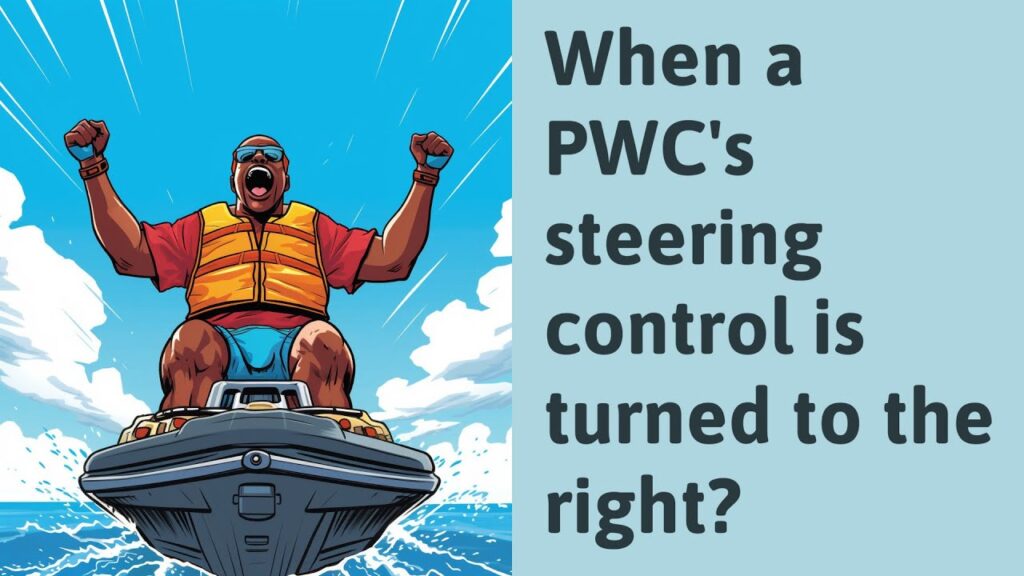What Happens When a PWC’s Steering Control is Turned to the Right?
Personal Watercraft (PWC), commonly known as jet skis, are popular for recreational use on water bodies. Understanding the mechanics of steering on a PWC is essential for safe operation. This article explores what happens when a PWC’s steering control is turned to the right, the underlying mechanics, and the implications for maneuvering and safety.
Overview of PWC Steering Mechanism
PWCs operate using a jet drive system, which is quite different from traditional boats that use propellers. In a jet drive system, water is drawn into the craft, pressurized, and expelled through a nozzle at the rear. The direction of this nozzle determines the PWC’s steering capabilities.
Key Components of PWC Steering
- Steering Control: The handlebars allow the rider to control the direction of the PWC.
- Steering Nozzle: Located at the back of the PWC, this nozzle pivots to redirect the flow of water.
- Throttle Control: Engaging the throttle is crucial for maintaining steering control, as it propels the watercraft forward.
Mechanics of Steering Right
When the steering control is turned to the right, the following sequence of events occurs:
- Nozzle Movement: The steering nozzle at the back of the PWC pivots to the right.
- Water Jet Direction: The jet of water expelled from the nozzle is redirected to the right.
- Directional Change: As the water jet pushes the back of the PWC to the left, the front of the PWC turns to the right, resulting in a rightward movement.
This mechanism is essential for understanding how PWCs maneuver, especially in tight spaces or during high-speed operation.
Importance of Throttle Control
One critical aspect of steering a PWC is that the throttle must be engaged for effective maneuvering. If the throttle is released or the engine is turned off, the rider loses steering control. The PWC will continue in a straight line, regardless of the steering input.
Consequences of Releasing the Throttle
- Loss of Control: Releasing the throttle while attempting to steer can lead to a loss of maneuverability.
- Forward Momentum: The PWC will maintain its forward momentum, potentially leading to collisions or accidents.
Factors Influencing Steering
Several factors influence how effectively a PWC can be steered when the control is turned to the right:
- Speed: At higher speeds, PWCs are more responsive to steering inputs. However, at lower speeds, steering may be less effective.
- Weight Distribution: The rider’s weight distribution can impact the PWC’s handling. Leaning into the turn can enhance the turning response.
- Water Conditions: Waves, currents, and wind can affect how a PWC handles during turns. Riders must adjust their steering techniques based on these conditions.
Practical Applications of Steering Control
Understanding how to effectively steer a PWC is crucial for various scenarios:
- Navigating Tight Spaces: When approaching docks or other vessels, precise steering is necessary to avoid collisions.
- Emergency Maneuvers: In emergency situations, maintaining throttle and steering control can help avoid obstacles.
- Recreational Riding: For recreational riders, mastering steering techniques enhances the overall experience and safety.
Safety Considerations
Safety is paramount when operating a PWC. Here are some essential safety tips related to steering:
- Always Maintain Throttle: To retain steering control, keep the throttle engaged while maneuvering.
- Practice Steering Techniques: Familiarize yourself with how your PWC responds at different speeds and conditions.
- Be Aware of Surroundings: Keep a lookout for other vessels, obstacles, and changes in water conditions while steering.
- Use Reverse Cautiously: If your PWC has a reverse feature, practice using it at low speeds to understand its effects on steering.
Table of PWC Steering Mechanics
| Action | Resulting Effect | Notes |
|---|---|---|
| Turn Steering Control Right | Nozzle pivots right, water jet redirected right | PWC turns right as the back is pushed left by the water jet. |
| Release Throttle | Loss of steering control | PWC continues in a straight line regardless of steering input. |
| Engage Throttle | Maintains control and allows for effective steering | Essential for maneuvering and avoiding obstacles. |
| Lean into Turn | Enhances turning response | Improves stability and control during sharp turns. |
| Adjust Weight Distribution | Affects maneuverability | Proper weight distribution can enhance steering effectiveness. |
Frequently Asked Questions (FAQ)
Q1: What happens when I turn the steering control to the right on a PWC?
A: Turning the steering control to the right pivots the steering nozzle to the right, redirecting the water jet and causing the PWC to turn right.
Q2: Why is throttle control important for steering a PWC?
A: Throttle control is crucial because releasing the throttle results in a loss of steering ability. The PWC will continue in a straight line without directional control.
Q3: How does speed affect PWC steering?
A: At higher speeds, PWCs are more responsive to steering inputs. Lower speeds may reduce steering effectiveness, making precise maneuvering more challenging.
Q4: What should I do if I need to steer quickly to avoid an obstacle?
A: Maintain throttle engagement while steering to ensure you retain control. Avoid releasing the throttle, as this will diminish your ability to maneuver.
Q5: Are there any safety tips for steering a PWC?
A: Yes, always keep the throttle engaged, practice steering techniques, be aware of your surroundings, and use reverse cautiously if equipped.
Conclusion
Understanding what happens when a PWC’s steering control is turned to the right is essential for safe and effective operation. The mechanics of steering, the importance of throttle control, and the factors influencing maneuverability are crucial elements for any PWC rider. By mastering these concepts, riders can enhance their skills, ensuring a safer and more enjoyable experience on the water.For more detailed information about personal watercraft and their operation, you can refer to this Wikipedia link.



